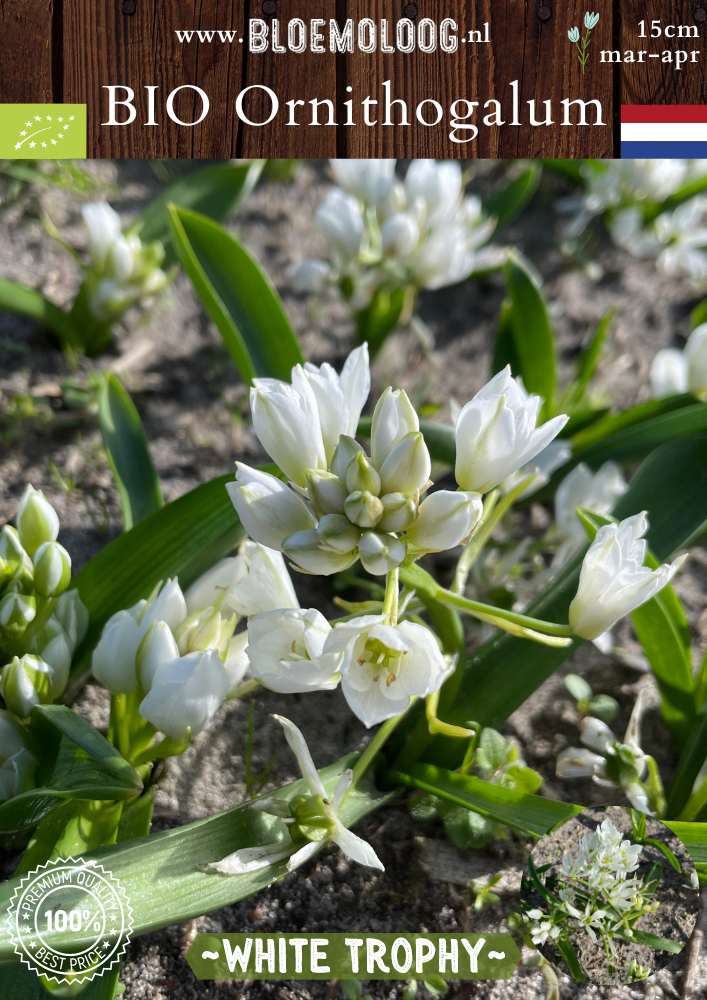Bloemoloog
Organic Ornithogalum 'White Trophy' - Broad-leaved bird's milk | 10+10 pcs.
Organic Ornithogalum 'White Trophy' - Broad-leaved bird's milk | 10+10 pcs.
Estimated Shipping Widget will be displayed here!
Couldn't load pickup availability
Organic broadleaf bird milk
The Ornithogalum oligophyllum 'White Trophy', also known as the 'broad-leaved bird's milk', is a beautiful special spring bloomer. Her flowers are white and have star-shaped petals with graceful green stripes on the outside. It grows wide, inwardly curled leaves of about 15 centimeters long. The 'White Trophy' already blooms in March and therefore blooms earlier and is lower than most Ornithogalum species. The short flower stem sometimes has more than 10 flowers, causing it to bloom for weeks.
Ornithogalum oligophyllum 'White Trophy' has longer and grayer leaves than the Ornithogalum balansae, which was found in our range in previous years.
Like the crocus, it can be used as a top layer in your lasagna pots or in the garden. It serves as an excellent nectar source for bees and other pollinators. In addition, it is very suitable for naturalization and returns reliably year after year, regardless of the soil type.
How, where and when do I plant bird's milk flower bulbs?
Plant the bird's milk flower bulbs in the fall, preferably between September and January. This gives them plenty of time to root before winter sets in. Choose a location in the garden that is sunny to slightly shaded. Bird's milk grows best in well-drained soil. Dig up the soil and remove any weeds, rocks or other contaminants. Add compost or organic matter to improve soil structure and fertility.
Dig a planting hole that is about 2 to 3 times as deep as the height of the flower bulb. For broadleaf bird's milk, a depth of about 5 to 10 centimeters is usually suitable. Keep a distance of about 5 to 10 centimeters between each flower bulb. This gives the bulbs plenty of room to grow and multiply. Place the flower bulbs in the planting hole with the pointed side up. Then cover them with soil and press gently to firm the soil around the bulbs. After planting, water the bird's milk flower bulbs well. This helps them get settled and encourages initial growth.
If necessary, apply a layer of organic mulch material around the plants to retain moisture and reduce weed growth.
Care
Water regularly, especially during the growing period in spring. Keep the soil evenly moist, but avoid over-watering to prevent rotting of the bulbs. Provide a light dose of balanced fertilizer once a month in spring to stimulate growth. We recommend Bio Kultura for organic potting soil, plant food and other soil improvers!
Regularly remove spent flowers to focus the plant's energy on bulb growth rather than seed formation. After flowering, the plant goes into a rest period. The foliage will naturally wither and die. Leave the foliage alone until it dries completely before carefully removing it. The Ornithogalum oligophyllum 'White Trophy' naturalizes well and comes back reliably every year!
Origin
Ornithogalum oligophyllum is a bulbous plant belonging to the Hyacinthaceae family. The origin of Ornithogalum oligophyllum lies in Southwest Asia and North Africa, where it occurs naturally. It grows there in diverse environments, including grasslands, rocky slopes and forest edges.
Buy Organic Ornithogalum oligophyllum 'White Trophy'
Skal NL-BIO-01 certified: 109459
Packed per 20 flower bulbs or choose a stacking discount.
Stacking discount: E
Can be ordered from June '25!
EU shipping €8.95 - Free shipping from €100 purchase.
Characteristics
| Flowering time: | March - April |
| Planting time: | From September |
| Planting depth: | 5 cm deep |
| Planting distance: | 5 cm apart |
| Height: | 15 cm high |
| Flower diameter: |
5cm wide |
| Location: | Partial shade, sun |
| Soil PH: | Loam, sandy soil - Slightly alkaline/neutral |
| Winter hardiness: | Very hardy |
| Propagation: | Good (naturalizes) |
| Origin: | Turkey and surroundings |
| Family: | Hyacinthaceae (hyacinth family) |
| Colour: | White with green stripes |
| Bee-friendly: | Yes |
| Fragrant: | No |
| Bulb size: | 5+ |

NL-BIO-01
To share






